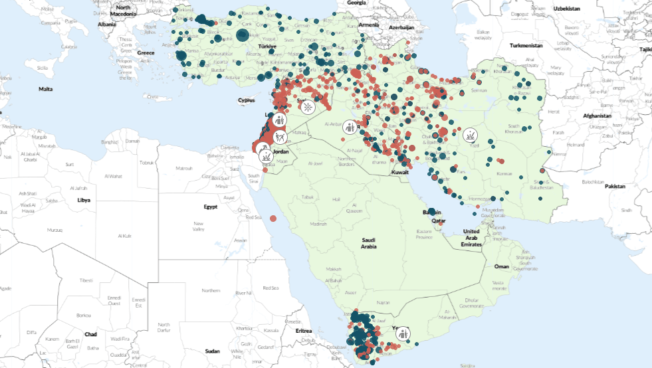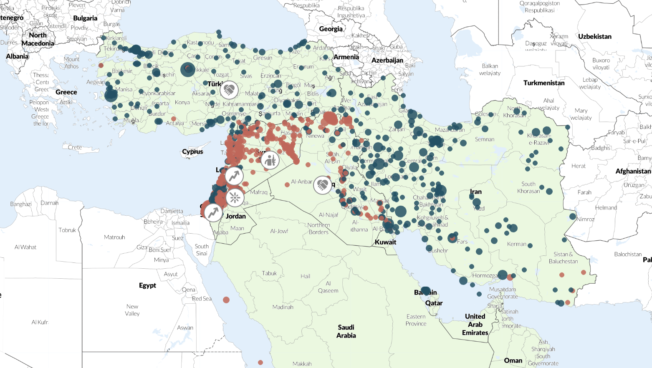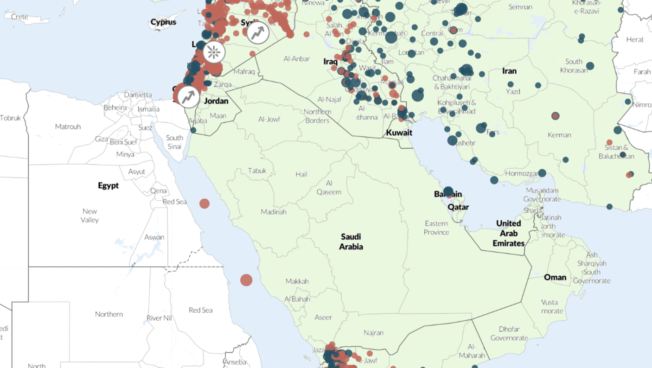Regional Overview
Middle East
April 2025
Posted: 4 April 2025
In this Regional Overview covering March 2025
- Gaza: Ceasefire collapses as Israel intensifies pressure on Hamas
- Lebanon-Israel: Renewed tensions threaten ceasefire amid regional unrest
- Syria: Israel intensifies its airstrikes and incursions in southern Syria
- Turkey: Istanbul mayor’s arrest sparks nationwide protests
- Yemen: The US launches its most intensive airstrikes campaign to date
Gaza: Ceasefire collapses as Israel intensifies pressure on Hamas
On 18 March, Israel resumed widespread airstrikes across Gaza after nearly two months of ceasefire, with ACLED recording over 300 airstrike events in March — nearly 10 times the airstrikes in February. The ceasefire collapsed after Hamas rejected a US proposal to extend the truce in exchange for 15 Israeli hostages, arguing it undermined the second phase of the agreement aimed at a permanent ceasefire.1The New Arab, “Hamas rejects Witkoff’s new proposal for Gaza truce extension,” 14 March 2025
As part of the renewed offensive, Israeli troops expanded the buffer zone, retaking the eastern section of the Netzarim corridor and partially disconnecting northern and southern Gaza. Troops advanced into Bait Lahiya and moved from the Philadelphi corridor toward Rafah camp and al-Mawasi, encircling the Tal al-Sultan area west of Rafah. Hamas and other armed groups avoided direct clashes but fired several rockets toward Israel, causing no casualties or property damage. Overall, Israeli operations resulted in around 950 deaths among Palestinians in March, including civilians, militants, and top officials and commanders — more than six times the fatalities recorded in February. Notably, among those killed were four members of Hamas’ political bureau, including Ismail Barhoum, the head of Hamas’ civil and financial administration in Gaza.2Emanuel Fabian and Nurit Yohanan, “Senior Hamas official killed in targeted strike on Gaza hospital as IDF widens offensive,” Times of Israel, 24 March 2025
The Israeli government has asserted that negotiations will proceed “under fire” until Hamas is disarmed and its leaders depart Gaza.3Lazar Berman, “PM: Cabinet voted for more IDF pressure on Hamas; Israel to run Gaza security when Hamas gone,” Times of Israel, 30 March 2025 While Hamas continues to view disarmament as a “red line,” it has shown flexibility in releasing five living hostages in exchange for an extended ceasefire and increased humanitarian aid into Gaza.4James Mackensie and Nidal Al-Mughrabi, “Israeli PM Netanyahu vows to pressure Hamas after ceasefire proposal,” Reuters, 30 March 2025 Limited anti-Hamas protests surfaced during March in Gaza, the first since February 2024, intensifying pressure on the group amid rising public discontent. The launch of a new Israeli ground operation on 2 April will likely increase pressure on Hamas by further preventing humanitarian aid and targeting new areas.5The Time of Israel, “Katz says offensive aimed at seizing ‘extensive territory,’ as IDF pounds south Gaza,” 2 April 2025
For more information, see ACLED’s Gaza Monitor.
Lebanon-Israel: Renewed tensions threaten ceasefire amid regional unrest
March saw tensions between Hezbollah and Israel escalate to their highest level since the ceasefire took effect in November 2024, with ACLED recording a 100% increase in airstrikes and drone attacks by the Israeli military in Lebanon compared to February 2025, and the highest number of airstrike events in Lebanon since November 2024.
On 22 and 28 March, rockets were fired from Lebanon at Israel for the first time since the November 2024 ceasefire. Hezbollah denied responsibility, hinting at another faction within its sphere of influence.6Hugo Bachega and Jaroslav Lukiv, “Israel strikes Lebanon after first rocket attack since ceasefire,” BBC, 22 March 2025 Regardless of Hezbollah’s involvement, the attacks came amid rising regional tensions, including renewed fighting in Gaza, the commemoration of al-Quds Day on 28 March — an annual event in solidarity with the Palestinian cause — and Houthi attacks from Yemen. In response, Israel carried out an airstrike campaign against Hezbollah, holding the Lebanese government responsible for not reining Hezbollah in.7Herb Keinon, “Israel recalibrating rules of war after Hezbollah rockets, strike in Beirut – analysis,” The Jerusalem Post, 30 March 2025
In addition to their intensity, the airstrikes stood out for the high number of reported fatalities — over 30, the highest since December 2024 — and their expanded geographic scope. Notably, on 28 March, Israel struck Beirut for the first time since the ceasefire, marking a shift from previous attacks focused on southern Lebanon and the Bekaa, where the IDF claims it was targeting Hezbollah infrastructure and weapons depots. The ceasefire has so far remained in force despite these renewed flare-ups, but regional tensions, including the resumption of fighting in Gaza and the United States’ strikes against the Houthis in Yemen, threaten the fragile truce in Lebanon.
For more information, see the Israel-Hezbollah weekly situation update.
Syria: Israel intensifies its airstrikes and incursions in southern Syria
In March, Israel escalated military operations in Syria’s southern provinces with the aim of demilitarizing the region and establishing a new buffer zone.8Reuters, “Israel says its troops in Syria will remain atop Mt Hermon indefinitely,” 28 January 2025 Operations mostly focused on the al-Qunaytira, Daraa, and Rural Damascus provinces, reinforcing the upward trend observed in February, with violence doubling in March compared to the previous month.
Israeli airstrikes on Syrian territory increased by 140% in March compared to the month prior and saw a geographical expansion. Israeli warplanes conducted eight airstrikes on Syrian military positions in the province of Homs — targeting former Syrian army outposts reportedly being used by the forces of Syria’s new authorities9PressTv, “Israeli jets target ex-military bases in Syria’s Homs in new act of aggression,” 19 March 2025 — and air bases.
Further, ground incursions increased by 30%, with around 35 recorded in March, up from 25 in February. These actions enabled an expansion of Israel’s area of operations into al-Qunaytira and Daraa, leading to the destruction of several Syrian army positions and intensified attacks on civilian property. This escalation culminated in an attack on the village of Kuya in Daraa on 25 March, where local residents fired warning shots to deter Israeli forces from advancing into the village. In response, Israeli forces launched an airstrike and shelled the village, killing at least six civilians.10Charles Lister, “Israel is escalating its war in Syria, Foreign Policy Magazine, 27 March 2025
Turkey: Istanbul mayor’s arrest sparks nationwide protests
On 19 March, Ekrem İmamoğlu, the popular mayor of Istanbul and member of the opposition Republican People’s Party (CHP), was detained on charges of corruption and aiding terrorism just ahead of his confirmation as the lead candidate for the 2028 presidential election. His arrest, along with 106 others11Human Rights Watch, “Türkiye: Istanbul mayor detained, mass detention a politically motivated attack on the opposition,” 19 March 2025 — including high-ranking municipal officials and district mayors also from CHP — triggered widespread outrage and was widely viewed as an attempt to eliminate the most serious opponent to President Recep Tayyip Erdoğan’s rule.
Since İmamoğlu’s detention, hundreds of thousands have taken to the streets in demonstrations demanding his release and judicial independence.12Ezgi Akin, “Turkey: Protests spread, defy ban for day 3 over Imamoglu’s arrest,” Al-Monitor, 21 March 2025 While CHP organized most events, demonstrators included students, activists, labor groups, and members of various opposition parties, making it the largest wave of anti-government demonstrations in Turkey since the 2013 Gezi protests. ACLED data show that between 19 and 28 March, nearly 220 demonstrations against İmamoğlu’s arrest took place in Turkey across around 100 locations. While the majority were peaceful, 46 were met with police intervention, and four featured violence against police. These demonstrations drove Turkey to see its highest number of monthly demonstrations since June 2024.
The government dismissed claims of political persecution and accused protesters of inciting violence, imposing gathering bans in major cities like Istanbul, Ankara, and Izmir, where demonstrations faced police intervention almost daily. At the same time, the total number of detainees in Turkey exceeded 1,900,13Shubhangi Derhgawen, “Turkey: 1,900 protesters detained after Imamoglu’s arrest,” Deutsche Welle, 27 March 2025 among them journalists and opposition figures. The unrest highlights growing dissatisfaction with Erdoğan’s administration as demonstrators rally for justice and democratic rights. The events have become a significant turning point in Turkish politics, reflecting deepening tensions and calls for change.
Yemen: The US launches its most intensive airstrikes campaign to date
In March, US forces resumed airstrikes on Houthi targets with unprecedented intensity, following a halt in operations since the Gaza ceasefire on 19 January. ACLED records 136 airstrike events since 15 March — the largest number of US airstrikes in Yemen in a single month since coverage began in 2015. This renewed campaign stemmed from two major developments: the US’ listing of the Houthis as a foreign terrorist organization on 4 March14US Department of State, “Designation of Ansarallah as a Foreign Terrorist Organization,” 4 March 2025 and the collapse of the Hamas-Israel ceasefire, which led the Houthis to announce a ban on Israeli ships in the Red Sea a week later.15X@AmeenHa2024yan, 11 March 2025 (Arabic) Its unprecedented scale is also likely due to the Trump administration’s desire to break with its predecessor’s policies vis-a-vis the Red Sea crisis.16White House, “Trump Administration’s Actions Made Houthi Terrorists Pay,” 25 March 2025
Washington’s declared objective is to restore deterrence by degrading Houthi capabilities to launch attacks in the Red Sea while also sending a message to Iran.17Phil Stewart and Mohammed Ghobari, “Trump launches large-scale strikes on Yemen’s Houthis, at least 31 killed,” Reuters, 16 March 2025 US strikes targeted Houthi military camps, bunkers, weapons storage facilities, and civilian areas, with around 80% of the attacks concentrated on the capital, Sanaa, and the two governorates of Saada and Hudayda. The strikes reportedly killed at least 122 people, though estimates vary significantly. In particular, the ratio of Houthi officers to civilian fatalities is unclear.18X @BashaReport, X, 28 March 2025; Al Mashhad News, “Abdul-Malik al-Houthi’s brother, the Houthi chief of staff, and dozens of other leaders were killed in US airstrikes,” 27 March 2025 (Arabic) Yet, based on the Houthis’ obituaries and reports by anti-Houthi sources,19Al Arabiya, “For the eleventh day… Houthi barracks, hideouts and and storage sites under American fire,” 25 March 2025 (Arabic); Yemen News Agency (SABA), “Funeral of a group of martyrs of the homeland and the armed forces in Sana’a,” 25 March 2025 (Arabic); Al Mashhad News, “Abdul-Malik al-Houthi’s brother, the Houthi chief of staff, and dozens of other leaders were killed in US airstrikes,” 27 March 2025 (Arabic) it is plausible that senior group members were among those targeted, including commanders responsible for Houthi operations in the Red Sea and relatives of the group’s leader (for more see this expert comment).
The Houthis responded to the strikes by launching at least 24 drone and missile attacks against US warships in the Red Sea and against Israel, but spared commercial shipping, resuming a pattern observed since September 2024. Their attacks consistently failed to hit their intended targets or were intercepted by US or Israeli forces. Notably, the group did not follow through on its threat to target Israeli commercial ships.
For more, see the Red Sea attacks interactive map created as part of the Yemen Conflict Observatory.
See More
See the Codebook and the User Guide for an overview of ACLED’s core methodology. For additional documentation, check the Knowledge Base. Region-specific methodology briefs can be accessed below.
Links:
For additional resources and in-depth updates on the conflict in Yemen, check our dedicated Yemen Conflict Observatory.







